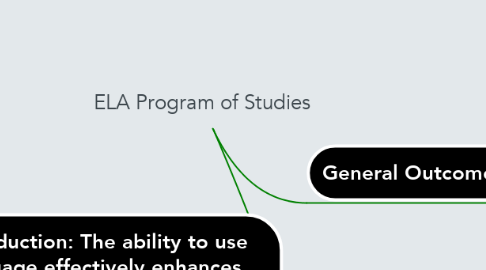
1. Introduction: The ability to use language effectively enhances student opportunities to experience personal satisfaction and to become responsible, contributing citizens and lifelong learners
1.1. The Importance of Language
1.1.1. The Nature of Language: As well as being a defining feature of culture, language is an unmistakable mark or personal identity and is essential for forming interpersonal relationships, extending experiences, reflecting on thought and action, and contributing to society
1.1.2. Language Acquisition and Development: Language learning is an active process that begins at birth and continues throughout life. Children learn language as they use it to communicate their thoughts, feelings and experiences; establish relationships with family members and friends; and strive to make sense and order of their world
1.1.3. Language Learning- A Shared Responsibility: Responsibility for language learning is shared by students, parents, teachers and the community. Schools provide environments where students develop language knowledge, skills and strategies to achieve academic, personal and social goals.
1.1.4. Thinking and Learning through Language: Thinking, learning and language are interrelated. Language enables students to play an active role in various communities of learners within and beyond the classroom
1.2. English Language Arts
1.2.1. Listening and Speaking: Listening and speaking enable students to explore ideas and concepts, as well as to understand and organize their experiences and knowledge.
1.2.2. Reading and Writing: Reading and writing are powerful means of communicating and learning. They enable students to extend their knowledge and use of language, increase their understanding of themselves and others, and experience enjoyment and personal satisfcation
1.2.3. Viewing and Representing: Viewing and representing are integral parts of contemporary life. These skills allow students to understand the ways in which images and language may be used to convey ideas, values, and beliefs
1.2.4. Texts: In today's technological society, people access information and find enjoyment in print, as well as other language forms. For example, oral communication and visual media are becoming increasingly important.
2. General Outcomes
2.1. General Outcome 1: Students will listen, speak, read, write, view and represent to explore thoughts, ideas, feelings, and experiences
2.1.1. 1.1 Discover and explore
2.1.1.1. Express ideas and develop understanding. Experiment with language and forms. Express preferences. Set goal.
2.1.1.1.1. Specific Outcome: Kindergarten- share personal experiences prompted by oral, print and other media texts
2.1.2. 1.2 Clarify and extend
2.1.2.1. Consider the ideas of others. Combine ideas. Extend understanding.
2.1.2.1.1. Specific Outcome: Grade 1- Listen and respond appropriately to experiences and feelings shared by others
2.2. General Outcome 2: Students will listen, speak, read, write, view and represent to comprehend and respond personally and critically to oral, print and other media texts
2.2.1. 2.1 Use strategies and cues
2.2.1.1. Use prior knowledge. Use comprehension strategies.
2.2.1.1.1. Specific Outcome: Grade 2- use knowledge of how oral and written language is used in a variety of contexts to construct and confirm meaning
2.2.2. 2.2 Respond to texts
2.2.2.1. Experience various texts. Construct meaning from text.
2.2.2.1.1. Specific Outcome: Grade 3- tell or write about favorite parts of oral, print and other media texts
2.2.3. 2.3 Understand forms, elements and techniques
2.2.3.1. Understand forms and genres. Understand techniques and elements. Experiment with language.
2.2.3.1.1. Specific Outcome: Grade 4- describe and compare the main characteristics of a variety of oral, print and other media texts
2.2.4. 2.4 Create original text
2.2.4.1. Generate ideas. Elaborate on the expression of ideas.
2.2.4.1.1. Specific Outcome: Grade 5- use texts from listening, reading and viewing experiences as models for producing own oral, print and other media texts
2.3. General Outcome 3: Students will listen, speak, read, write, view and represent to manage ideas and information
2.3.1. 3.1 Plan and focus
2.3.1.1. Focus attention, determine information needs, and plan to gather information.
2.3.1.1.1. Specific Outcome: Grade 6- distinguish among facts supported inferences and opinions
2.3.2. 3.2 Select and process
2.3.2.1. Use a variety of sources, access information, and evaluate sources.
2.3.2.1.1. Specific Outcome: Kindergarten- seek information from a variety of sources, such as people at school, at home, in the community, picture books, photographs and videos
2.3.3. 3.3 Organize, record and evaluate
2.3.3.1. Organize information, records information, and evaluate information.
2.3.3.1.1. Specific Outcome: Grade 1- identify or categorize information according to sequence, or similarities and differences
2.3.4. 3.4 Share and review
2.3.4.1. Share ideas and information and review research process
2.3.4.1.1. Specific Outcome: Grade 2- share, with familiar audiences, ideas and information on topics
2.4. General Outcome 4: Students will listen, speak, read, write, view and represent to enhance the clarity and artistry of communication
2.4.1. 4.1 Enhance and improve
2.4.1.1. Appraise own and others' work, revise and edit, enhance legibility, expand knowledge of language, and enhance artistry.
2.4.1.1.1. Specific Outcome: Grade 3- share own oral, print and other media texts with others to identify strengths and ideas for improvement
2.4.2. 4.2 Attend to conventions
2.4.2.1. Attend to grammar and usage, attend to spelling, attend to spelling, and attend to capitalization and punctuation.
2.4.2.1.1. Specific Outcome: Grade 4- identify simple and compound sentence structures, and use in own writing
2.4.3. 4.3 Present and share
2.4.3.1. Present information, enhance presentation, use effective oral and visual communication, and demonstrate attentive listening and viewing.
2.4.3.1.1. Specific Outcome: Grade 5- organize ideas and information in presentations to maintain a clear focus and engage the audience
2.5. General Outcome 5: Students will listen, speak, read, write, view and represent to respect, support and collaborate with others
2.5.1. 5.1 Respect others and strengthen community
2.5.1.1. Appreciate diversity, relate texts to culture, celebrate accomplishments and events, and use language to show respect.
2.5.1.1.1. Specific Outcome: Grade 6- compare personal challenges and situations encountered in daily life with those experience by people or characters in other times, places and cultures portrayed in oral, print and other media texts
2.5.2. 5.2 Work within a group
2.5.2.1. Cooperate with others. Work in groups. Evaluate group process.
2.5.2.1.1. Specific Outcome: Kindergarten- participate in class and group activities

